Related Research Articles

Gary Ivan Gordon was a master sergeant in the United States Army and a recipient of the Medal of Honor. At the time of his death, he was a non-commissioned officer in the United States Army's premier special operations unit, the 1st Special Forces Operational Detachment-Delta (1SFOD-D), or "Delta Force". Together with his comrade, Sergeant First Class Randy Shughart, Gordon was posthumously awarded the Medal of Honor for his actions during the Battle of Mogadishu in October 1993.

Randall David Shughart was a United States Army Delta Force operator who was posthumously awarded the Medal of Honor for his actions during the Battle of Mogadishu, during Operation Gothic Serpent in October 1993.

Black Hawk Down is a 2001 war film directed and produced by Ridley Scott, and co-produced by Jerry Bruckheimer, from a screenplay by Ken Nolan. It is based on the 1999 eponymous non-fiction book by journalist Mark Bowden, about the crew of a Black Hawk helicopter that was shot down during the Battle of Mogadishu. The film features a large ensemble cast, including Josh Hartnett, Ewan McGregor, Eric Bana, Tom Sizemore, William Fichtner, Jason Isaacs, Sam Shepard, Jeremy Piven, Ioan Gruffudd, Ewen Bremner, Hugh Dancy, and Tom Hardy in his first film role. Orlando Bloom, Ty Burrell, and Nikolaj Coster-Waldau also have minor roles.
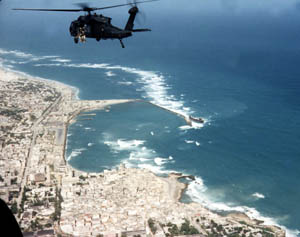
The Battle of Mogadishu, also known as the Black Hawk Down Incident, was part of Operation Gothic Serpent. It was fought on 3–4 October 1993, in Mogadishu, Somalia, between forces of the United States—supported by UNOSOM II—against the forces of the Somali National Alliance (SNA) and armed irregulars of south Mogadishu.

The 160th Special Operations Aviation Regiment (Airborne), abbreviated as 160th SOAR (A), is a special operations force of the United States Army that provides helicopter aviation support for special operations forces. Its missions have included attack, assault, and reconnaissance, and these missions are usually conducted at night, at high speeds, low altitudes, and on short notice.
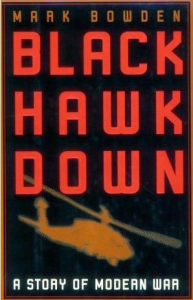
Black Hawk Down: A Story of Modern War is a 1999 book by journalist Mark Bowden. It documents efforts by the Unified Task Force to capture Somali faction leader Mohamed Farrah Aidid in 1993, and the resulting battle in Mogadishu between United States forces and Aidid's militia. One of the key events is the downing of two United States MH-60 Black Hawk helicopters, from which the book derives its title, and the attempt to rescue their crews. United States forces included 3rd Battalion, 75th Ranger Regiment; 160th SOAR; Delta Force; 24th Special Tactics Squadron; DEVGRU Navy SEALs; 10th Mountain Division; as well as Malaysian and Pakistani United Nations peacekeeping forces.

The 75th Ranger Regiment, also known as the Army Rangers, is the premier light infantry and direct-action raid force of the United States Army Special Operations Command. The 75th Ranger Regiment is also part of Joint Special Operations Command via the Regimental Reconnaissance Company (RRC). The regiment is headquartered at Fort Moore, Georgia and is composed of a regimental headquarters company, a military intelligence battalion, a special troops battalion, and three Ranger battalions.

The 1993 Battle of Mogadishu, more commonly known as Black Hawk Down, was detailed by the U.S. Army and lasted from October 3 to October 4 in 1993.

Operation Gothic Serpent was a military operation conducted in Mogadishu, Somalia, by an American force code-named Task Force Ranger during the Somali Civil War in 1993. The primary objective of the operation was to capture Mohamed Farrah Aidid, leader of the Somali National Alliance who was wanted by the UNOSOM II in response to his attacks against United Nations troops. The operation took place from August to October 1993 and was led by US Joint Special Operations Command (JSOC).

William F. "Bill" Garrison is a retired major general of the United States Army who commanded United States forces during Operation Gothic Serpent, the military operation launched in 1993 to capture Somali warlord Mohamed Farrah Aidid.

The Malaysian Army is the land component of the Malaysian Armed Forces. Steeped in British Army traditions, the Malaysian Army does not carry the title ‘royal’ as do the Royal Malaysian Navy and the Royal Malaysian Air Force. Instead, the title is bestowed on selected army corps and regiments who have been accorded the honour by the Yang di-Pertuan Agong, who is the Supreme Commander of the Malaysian Armed Forces.
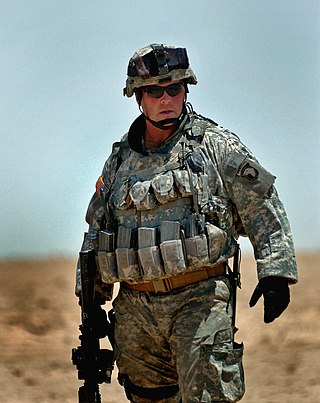
Michael Dane Steele is a retired colonel of the United States Army. He was a company commander in the 3rd Battalion, 75th Ranger Regiment during the Battle of Mogadishu (1993) in Somalia during Operation Gothic Serpent, which resulted in the now famous book and film Black Hawk Down, wherein he was portrayed by actor Jason Isaacs. He briefly appears in the documentary I Am an American Soldier.
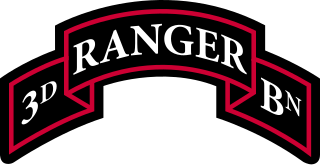
The 3rd Ranger Battalion is the third of three Ranger Battalions belonging to the United States Army's 75th Ranger Regiment. It is currently based at Fort Moore, Georgia.
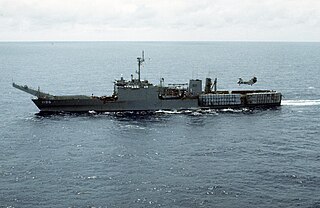
USS Harlan County (LST-1196) was a United States Navy tank landing ship of the Newport class. Entering service in 1972, the ship was active until decommissioned in 1995 and transferred to Spain. Renamed Pizarro, her Spanish service ended in 2012 and in 2013 it was reported that she would be sold to Angola as part of a package with the Spanish aircraft carrier Príncipe de Asturias. This sale was not completed and, after further attempts to sell the ship were unsuccessful, she was sold for scrap in April, 2016; she was completely dismantled by November, 2016, in El Puerto de Santa Maria, Spain.

The M1117 Guardian, also denoted Armored Security Vehicle (ASV), is an internal security vehicle based on the V-100 and V-150 Commando series of armored cars. It was developed in the late 1990s for service with the United States' Military Police Corps. The first prototypes appeared in February 1997 and serial production of the M1117 commenced between 1999 and early 2000.
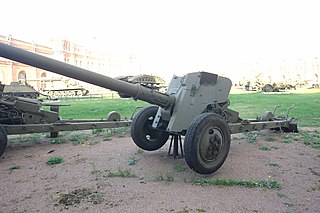
The Battle of Wadi al-Batin, also known as the Battle of Ruqi Pocket, took place before the beginning of the Desert Storm operations on 16 February 1991. This is not to be confused with the "Battle of Wadi al-Batin" which was fought later in the four-day ground war between elements of the 1st Cavalry Division and the Iraqi Republican Guard.
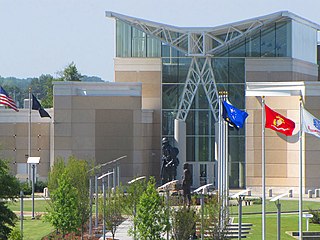
The United States Army Airborne & Special Operations Museum (ASOM) is part of the U.S. Army Museum Enterprise dedicated to preserving and teaching a public history of the Special Operations and Airborne community, as well as broader United States military history. Located on Fort Liberty, but geographically separate from the main installation, it has been open to the public in nearby downtown Fayetteville, North Carolina since 2000. The facility is staffed primarily by civilians and volunteers on a day to day basis, but remains owned and administered by the Army through the U.S. Army Center of Military History, a part of Training and Doctrine Command (TRADOC).
Corporal Mat Aznan bin Awang was a Malaysian Army soldier who served in the Malaysian Battilion (MALBATT) of the United Nations Operation in Somalia II. Mat Aznan was posthumously awarded the Seri Pahlawan Gagah Perkasa (SP) for his actions during the Battle of Mogadishu on October 1993. He was a Royal Malay Regiment soldier and hailed from Kampung Parit Panjang, Baling, Kedah.
Delta Force is a series of first-person shooter video games by NovaLogic created in 1998. They are often included in the sub-genre labeled "tactical shooters". NovaLogic was the primary developer and license holder of the franchise until the acquisition of its assets by THQ Nordic on October 31, 2016.
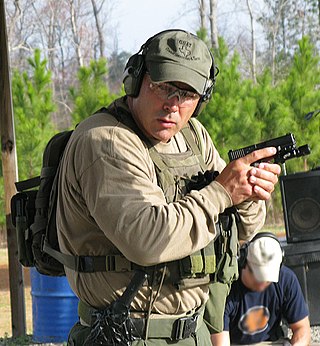
Paul Randal Howe is an American former special operations soldier. He was a Delta Force team leader who was involved in special operations as a U.S. Army soldier. He participated in the special operations rescue at the Battle of Mogadishu (1993) which led to the book Black Hawk Down: A Story of Modern War and the Black Hawk Down film. He is a firearms instructor and counterterrorism expert who trains people in high-risk operations. His company is called CSAT-Combat Shooting and Tactics. He is the author of three books about leadership.
References
- ↑ Bowden, Mark, Black Hawk Down: A Story of Modern War, Signet, 2001 - p.288
- ↑ Bowden, Mark, Black Hawk Down: A Story of Modern War, Signet, 2001 - p.350
- ↑ Col. Lee A. Van Arsdale. "Audio Commentary by Task Force Rangers". Black Hawk Down 3-Disk Deluxe Edition
- ↑ https://search.worldcat.org/title/798085124